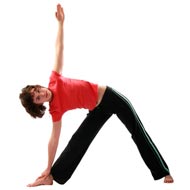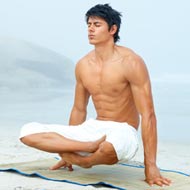Standing Exercises & Positions
By improving the tone and strength of the intercostals muscles, we can breathe slower, deeper and with much rhythm. In the earlier chapter we discussed about exercises sitting in chair.
But in this chapter we will be discussing exercises in standing position.
Many people are not attracted by the idea of practicing relaxation exercises in standing positions, especially in office atmosphere.
Their favorites are the sitting exercise. But these exercises are worth a try and I genuinely hope that you are able to practice at least a few ones in the office. If situations are not favorable you can try them at home.
When you want to exercise at office you can trace a like a guest room, a meeting room which is not used often. If there is such a place then you can take a break and practice your relaxation exercises for few minutes.
If you come across a quiet moment and have the space in the office then you can use the movements and sequences in this chapter. All our energies will be balanced with their help. If you are feeling tired and weak they will wake you and get you going. If you have been anxious about work then it will calm you down and focus your mind.
As per the requirement of this chapter you will have to learn to stand well as all the exercises and sequences start from it. Its better you practice learning to stand well, at home as it may take some time. Later you can include it in your little sessions at work.
If the position of the pelvis is right then you can stand well. The spine should be able to lengthen up from it and so it has to be centrally placed like while sitting. When you stand your pelvis is tipped forward. This leads to the forming of an unnecessary hollow in the small of the back. This prevents the spine from lengthening because the vertebrae get compressed.
'The discs', which form the cushioning matter of the vertebrae, due to continuous pressure and increase in the downward pull in gravity, are squeezed and flattened between the vertebrae. Ageing and lack of movement lead to the deterioration of the vertebrae. Correct posture and correct movement can slow down the process of deterioration. Prolapsed disc or slipped disc seems to appear all of a sudden which the result of strain and pressure is over a long period of time.
The Pelvic Tilt
Place your feet parallel to each other and hip width apart. Place your left hand at the back pointing in downward direction towards your tail bone and your right hand has to be placed in front just below your waist. Your fingertips should be pointing downwards towards your pubic bone.
Squeeze both your buttocks together at the same time as you exhale. Draw them down and in, so that your pelvis is tucked under you. The front of your body will lengthen when your lower abdominal muscles are drawn in. Place your hands and feel how your pubic bone tilts towards your face and at the back the pelvis moves down and under. For your pelvis this is the perfect position to be in.
Inhale and arch your back slightly by tilting the pelvis the other way, gently. As the top of pelvis tips forward note that the hollow in the small of your back is increasing.
You are required to differentiate between the two standing positions. So you have to repeat this exercise several times slowly.
Now you can try this exercise in another way. When you repeat the same movements, now place your hands on your hipbones. At the top of your pelvis, your tip bones move forward and back and you have to feel this.
Be aware of everything that is happening and practice this several times. This is a step towards learning to sense the correct, central position of your pelvis. Many people are used to over arching their lower back and so in the beginning the correct position will give you a strange feeling. The everlasting health of your spine depends on your ability to stand well. So don't give up continue your struggle to stand well.
If your pelvis is placed correctly in center then it can hold all the contents of the abdomen intact. When you stand with your pelvis tipped forward and your lower back arched, it affects the female reproductive organs negatively and hinders the eliminative and digestive process.
Standing
Learning to stand well is not as easy as it sounds. It seems very simple, but actually is a very complex process.
Stand with your feet hip width apart and parallel to each other. Note that when you do so, directly under your hips your feet should be lying.
Pull your shoulders back after lifting them. Then draw them away from your ears in downward direction. Your arms should be hanging loosely from your sides. Breathe in a normal manner.
See that your tongue should be resting loosely in the bottom of your mouth behind your lower teeth. See that it does not stick to the roof of your mouth. Your jaw and throat should be moist and soft. Continue to breathe in a steady manner. Avoid staring let your gaze be soft. Exhale in case you find that you are holding your breath and then can continue with your normal breathing.
Tuck your pelvis under you by squeezing both your buttocks together. Imagine that you have a tail and you are drawing it between your legs. This will allow your legs and thighs to lift up freely towards it and your pelvis will be in the center. It will even enable your spine to stretch up out of it.
When you perform this tucking movement your lower abdominal muscles begin to work and your abdomen flattens and lengthens. These abdominal muscles work together with your lower back muscles and buttocks to support your trunk. They even support and hold the contents of the abdomen together.
Now focus your concentration on the soles of your feet. Make necessary adjustments and see that your weight is distributed evenly among them. Your arches will be lifted when you press the balls of your feet into the ground.
Now you need to lift the muscles of the inside of your legs gently. Use the muscles at the front of your thighs to pull gently up on your kneecaps. The backs of your knees should feel soft so don't lock your knees or push them back rashly. Feel that your pelvis is centered very well and is supported by buttocks and your thighs.
Lengthen your spine upwards by lifting up out of your pelvis, keeping your shoulders down. Note that in all this your hands, arms and shoulders should not be involved.
Feel that from the top of your chest to your pubic bone you are lengthening up through the front of the body. At the same time there is a feeling of having created space between your ribcage and your hips.
The crown of your head should be facing the ceiling without you tensing your jaw or lifting your chin. Feel that space is being created between your shoulder and your ears when there is a feeling of lengthening in your neck. Imagine that to the crown of your head an invisible thread is attached and you are being pulled towards the ceiling.
Your chin should neither be pulling out nor pulling in and should be in level with the floor. Ensure that your neck is free, by moving your head from side to side a few times. And even see that your jaws are not tightened.
Breathe in a steady manner after having closed your eyes. Be attentive and observe your whole body when it is balanced, aligned, lifted and lengthened.
The Sanskrit word for this yoga posture is Tadasana, which means ';mountain posture'. The name relates with strength, stability, beauty and grandeur of the mountain.
Tadasana forms the basis for all other standing positions and movements and hence is of much importance. You can practice it while waiting for a bus or train, or in any other queue. You can find the necessary time and space for it always. It is also the easiest to practice.
Your personality and emotional state; your approach to people and how you respond to people and how they respond to you all depend a lot on your standing positions. Your daily routine involves a lot of standing, so its better you pay attention there. Stand well, tall and erect. When you are talking to someone don't shift all your weight onto one hip or keep shifting your weight from one foot to the other because your spine may move out of alignment. Let your weight be distributed evenly.



